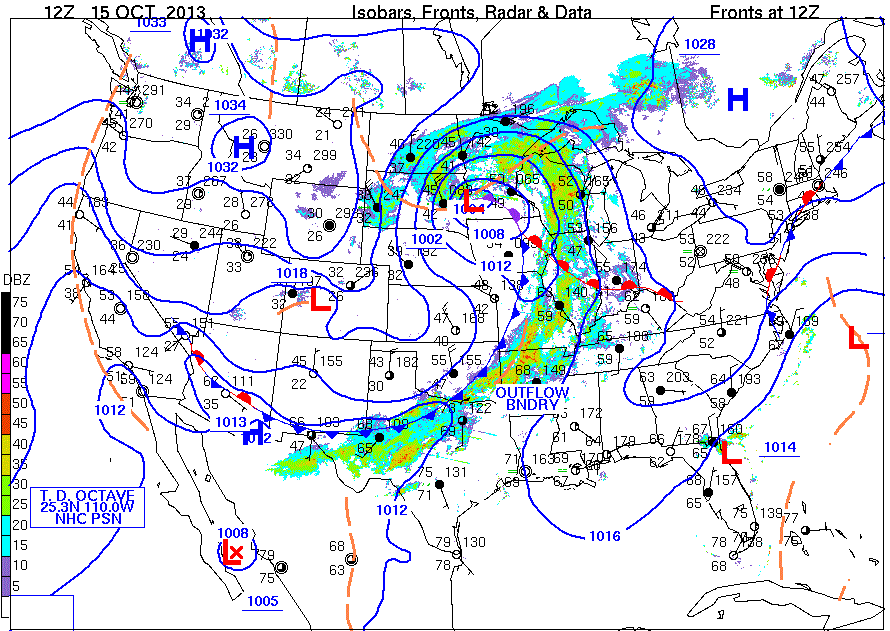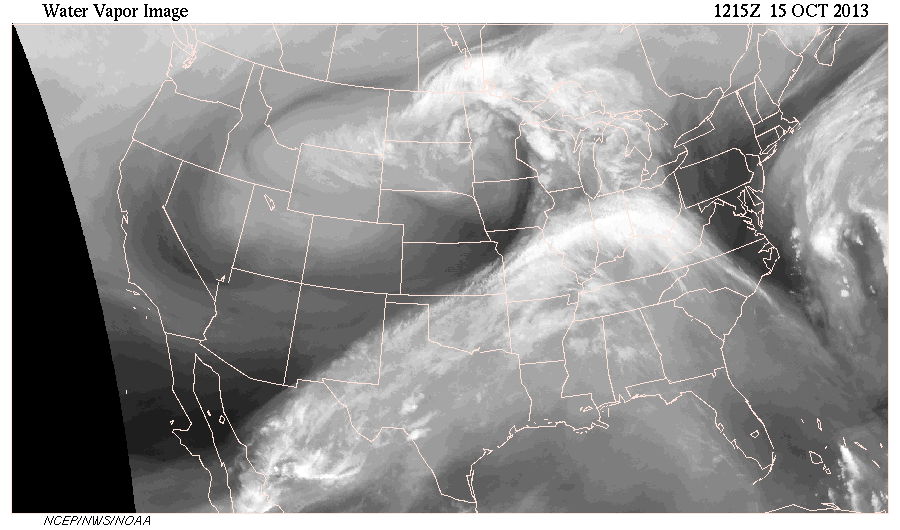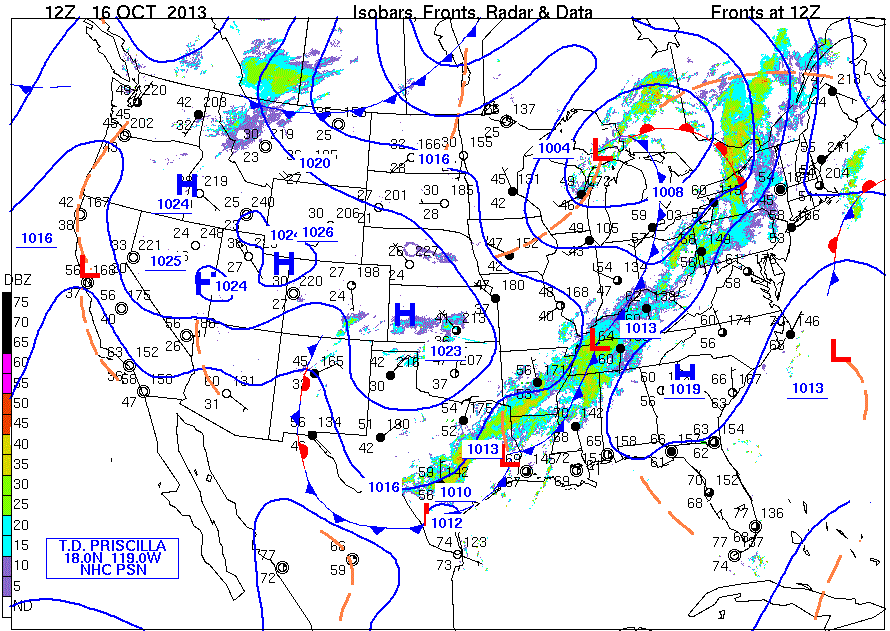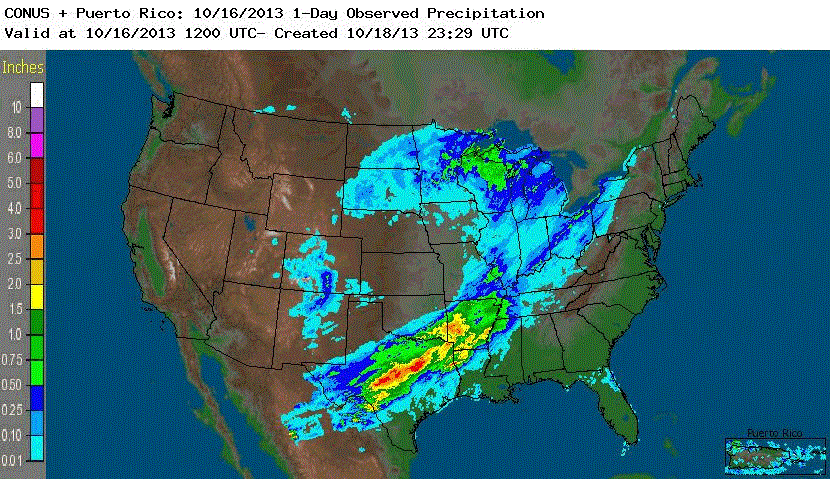PRECIPITATION PATTERNS
Objectives:
Rain and snow are not random and capricious acts of nature. This is especially evident when weather-radar echo patterns signifying precipitation are viewed along with weather maps and satellite images for the same times.
The basic mechanism for the formation of clouds and precipitation is the uplift and consequent cooling of air by expansion as discussed in Investigations 6A and 6B. In fact, uplift of air along the sloping surface of a front is the principal mechanism whereby the circulation in lows produces clouds and precipitation. Clouds and precipitation also may be associated with the upward branch of a convection current, uplift of air along the windward slopes of a mountain range, or convergence of surface winds. One of the most useful tools in following the development and movement of areas of precipitation is weather radar.
After completing this investigation, you should be able to:
- Describe different mechanisms leading to the formation of clouds and precipitation in low pressure systems.
- Locate areas of precipitation based on weather radar depictions.
- Indicate the general relationship between the uplift of air and the formation of clouds and precipitation.
Introduction:
Recall that a front is a line drawn on a surface weather map that marks a narrow transition zone between air masses differing in density (due to contrasts in temperature and/or humidity). An air mass, in turn, is a huge volume of air covering perhaps tens of thousands of square kilometers having generally uniform temperature and humidity characteristics in its horizontal extent.
1. A mass of cold, dry air is [(denser than)(not as dense as)] a mass of warm, humid air. Consequently, warmer (lighter) air is forced to rise above the sloping frontal surface overlying colder (denser) air.
2. Ascending unsaturated (clear) air [(expands)(is compressed)], cooling at about 10 Celsius degrees per 1000 meters of ascent (5.5 Fahrenheit degrees per 1000 feet).
3. The warmer air rising above the frontal surface expands and cools as it ascends, and its relative humidity [(increases)(decreases)]. If saturation is achieved, clouds develop and from those clouds, rain or snow may fall.
4. The relative humidity of saturated (cloudy) air is [(50%)(98%)(100%)(105%)].
5. Clouds (and perhaps precipitation) can develop in the ascending branch of a convection current, along a front, and up the windward slopes of a mountain range. The ascending branch of a convective current may produce an upwardly billowing cloud known as a [(cumulus)(stratus)(cirrus)] cloud.
6. Prevailing winds blow from west to east across most of North America. Winds that blow onshore from the Pacific Ocean are forced up the windward slopes of the Cascade Mountain Range in the Pacific Northwest. Hence, the heaviest precipitation falls on the [(western)(eastern)] slopes of the Cascades.
As directed by your course instructor, complete this investigation by either:
- Going to the Current Weather Studies link on the course website, or
- Continuing the Applications section for this investigation that immediately follows.
Investigation 7A: Applications
A passing storm system on October 15th and 16th, perhaps best displayed the variety of precipitation areas typically associated with a midlatitude cyclone or low-pressure system. The storm developed over northern Colorado and western Nebraska east of the Rockies. The storm then advanced eastward across the central portion of the country bringing widespread precipitation with some heavy in many locations. Figure 1 is the weather map from Tuesday morning, 12Z 15 OCT 2013. The Figure 1 map displays the surface frontal positions and the storm’s low pressure center at that time. The low-pressure center was shown within a 1004-mb isobar in southwestern Minnesota. An occluded front curved southeastward from the Low center to east-central Iowa. In Iowa, the meeting of occluded, warm and cold fronts formed a triple point. The warm front angled to the southeast while a cold front curved to the south and southwest. The low-pressure center with its fronts was advancing toward the northeast. High pressure systems preceded and followed the Low and its fronts.

Figure 1. Surface weather map for 12Z 15 OCT 2013.
7. The circulation about the Low center at map time was generally [(clockwise and outward)(counterclockwise and inward)].
8. The cold front stretching from Iowa to southeastern Arizona was advancing generally toward the [(west, northwest and north)(east, southeast and south)(southwest and west)].
9. The warm front was moving generally toward the [(southwest)(northeast)(northwest)(southeast)].
10. Station models from southern Texas to Georgia and Kentucky ahead of the cold front showed the air was relatively warm and dewpoints were relatively [(low)(high)] compared to stations behind the front.
11. Radar shadings indicate where the NWS national network of Doppler radars was detecting precipitation. The intensities of the echoes according to the scale at the left edge of the map were related to precipitation rates. From the map display, precipitation was broadly located [(north and northeast of the Low center)(in a curved band ahead of the cold front)(in both of these locations)].
12. In particular, the relationship of precipitation to the location of the cold front suggested that the air [(was)(was not)] lifted by advance of colder, denser air behind the front.
13. Precipitation also occurred in [(an extended band ahead of the occluded and warm fronts)(a narrow band parallel to just the warm front)].
Figure 2 is the water vapor satellite image for 1215Z 15 OCT 2013, the same time as the Figure 1 surface weather map. Mid-tropospheric water vapor and extensive cloud cover are detected by infrared wavelengths sensitive to water. Bright white shades indicate where thick clouds exist. Medium gray shades show where extensive water vapor occurs between about 700 mb and 400 mb. And dark shades show areas of relatively dry air.

Figure 2. Water vapor satellite image for 1215Z 15 OCT 2013.
14. Bright white shadings in the water vapor image generally [(do)(do not)] coincide with where radar echoes on the Figure 1 map indicated precipitation was occurring.
Figure 3 is surface weather map from Wednesday morning, 12Z 16 OCT 2013. This map displays the storm’s positions (low pressure center and fronts) twenty-four hours following the Figure 1 map. The low-pressure center was located over the upper peninsula of Michigan at this map time. Other local areas of low pressure had formed along the cold front.

Figure 3. Surface weather map for 12Z 16 OCT 2013.
15. The movement of the frontal systems generally [(did)(did not)] proceed as their symbols indicated on the Figure 1 map. This should confirm your answers to items 8 and 9.
16. At Figure 3 map time, the radar echoes [(did)(did not)] show that precipitation was occurring in advance of the warm front.
17. The band of precipitation associated with the cold frontal boundary generally [(was)(was not)] along the front although occurring ahead of it to the north and somewhat behind it to the south.
Figure 4 is the one-day, water-equivalent total precipitation ending at 1200Z on 16 October 2013 over the contiguous U.S. from NOAA’s National Weather Service’s Advanced Hydrological Prediction Service. The Figure 1and Figure 3 maps showed the Low center and frontal positions at the beginning and end of this total precipitation mapping. Shadings indicate precipitation totals according to the scale along the left margin of the image.

Figure 4. One-day observed total precipitation in the contiguous U.S. ending at 12Z 16 OCT 2013.
18. The greatest precipitation amounts are shown as yellow, orange, and red areas, mainly across central Texas. These shadings of the heaviest precipitation [(did)(did not)] generally fall where relatively intense radar echoes were associated with the cold front. Also, note that the precipitation area moved relatively little over the twenty-four hour period giving long-lasting heavy rains to those areas.
19. The red shadings over central Texas indicate that these locations received [(less than 1)(from 1 to 3)(over 3)] inch(es) of precipitation in this twenty-four hour period.
This passing midlatitude cyclone shows some of the ingredients for precipitation: sufficient water vapor in the air to form clouds and precipitation, along with an advancing frontal system for lifting the air. The concentration of these factors leads to the positioning of precipitation. A later investigation will focus on thunderstorm formation mechanisms.
Suggestions for further activities: When precipitation is expected or occurring in your area, you can consult local weathercasts for observations of the location and total amounts over a particular time period. You may wish to explore the current radar information provided by NOAA’s NWS Radar page, linked from the Radar section of the website. Most browsers will allow you to run animations of the images (loop) or you can select a regional scale image below the large view. Precipitation reflectivity, radial velocity and storm total view and animations are available from individual stations by clicking on the map.
Remember, the course website provides both static images and animations of weather products. There, you can quickly and directly observe thumbnail animations of the most recent radar and IR and water vapor satellite imagery.